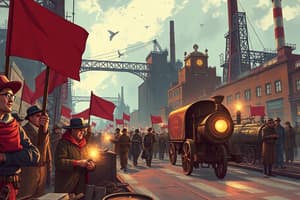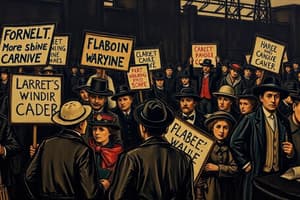Podcast
Questions and Answers
¿Qué consecuencia negativa tuvo la mayor división de tareas y especialización en la Revolución Industrial?
¿Qué consecuencia negativa tuvo la mayor división de tareas y especialización en la Revolución Industrial?
- Aumento del salario de los trabajadores especializados.
- Mejora en las condiciones de trabajo de los niños.
- Mayor seguridad laboral para todos los trabajadores.
- Menos oportunidades para trabajadores con bajo nivel de habilidades. (correct)
¿Qué aspecto de las condiciones laborales durante la era industrial hizo que muchos trabajadores estuvieran expuestos a productos químicos peligrosos y componentes de maquinaria?
¿Qué aspecto de las condiciones laborales durante la era industrial hizo que muchos trabajadores estuvieran expuestos a productos químicos peligrosos y componentes de maquinaria?
- Horas de trabajo prolongadas.
- Mala iluminación en las fábricas.
- Falta de descanso adecuado para los niños.
- Ausencia de medidas de seguridad en el lugar de trabajo. (correct)
¿Qué función desempeñaron las asociaciones comerciales en el surgimiento de los sindicatos laborales durante la Revolución Industrial?
¿Qué función desempeñaron las asociaciones comerciales en el surgimiento de los sindicatos laborales durante la Revolución Industrial?
- Proporcionar capacitación especializada a los trabajadores.
- Ofrecer asistencia financiera a los trabajadores enfermos. (correct)
- Organizar huelgas en protesta por los bajos salarios.
- Negociar mejores salarios y condiciones laborales para los trabajadores.
¿Qué logro importante se menciona en el texto como resultado de las preocupaciones sobre las condiciones laborales durante la Revolución Industrial?
¿Qué logro importante se menciona en el texto como resultado de las preocupaciones sobre las condiciones laborales durante la Revolución Industrial?
¿Cuál fue el objetivo principal de los Knights of Labor durante la Revolución Industrial?
¿Cuál fue el objetivo principal de los Knights of Labor durante la Revolución Industrial?
Study Notes
The Industrial Revolution and the Labor Movement: An Overview
The Industrial Revolution marked a turning point in the development of the global economy. Its effects spanned industries, economies, and societies around the globe. During this period, the nature of work, the distribution of wealth, and the relationships between capitalists and workers fundamentally shifted. Key to understanding the impact of the Industrial Revolution is exploring the societal changes wrought by industrialization, the implications for working conditions, the rise of labor unions, and the emergence of socialist thought.
Industrialization
The Industrial Revolution, characterized by the transition from agrarian, rural societies to urban ones dominated by industry and machine manufacturing, brought significant changes in labor processes. It led to the increase of mechanized productions, mass assembly lines, and the spread of factories (Blum, 1937). As a result, the workforce was required to match the pace of increased productivity demands and the need for specialized skills. In contrast to traditional cottage industries where workers operated at home or in small workshops, industrial workers tended to work in large factories, offices, and other centralized places of business.
Moreover, the scale of production expanded rapidly due to the development of machinery driven by energy sources like coal and petroleum. This led to a greater division of tasks along with specialization, as each worker would focus on a specific process rather than completing multiple tasks. Consequently, greater efficiency was achieved, allowing production to reach unprecedented levels. However, it also resulted in fewer opportunities for low-skill workers, leading to a growing class divide (Berg & Maxwell-Hyslop, 2010).
Working Conditions
During the industrial era, working conditions were generally harsh and hazardous. Many industrial jobs entailed long hours and physically demanding labor, causing numerous injuries. Moreover, working conditions were often unsanitary and detrimental to the health of the workers. Children, particularly girls, were often employed for cheap labor in factories and textiles, sometimes working for more extended periods without proper rest. There were minimal safeguards in place regarding workplace safety, leaving many factory workers exposed to dangerous chemicals and machinery components.
However, concerns over working conditions gradually led to stricter regulations and improvements. Collective efforts from workers, politicians, and reform movements, including the labor union movement, ultimately influenced legislatures to introduce labor protection measures. One notable milestone was the introduction of Factory Acts, starting in the United Kingdom, which established limits on working hours, prohibited child labor, and imposed safety standards in certain industries (Gray, 2016).
Labor Unions
As industrialization intensified, so did the need for organized collective representation for the interests of laborers. Labor unions emerged as a means for workers to negotiate better wages, working conditions, and benefits. Initially, trade associations served as loose networks of skilled craftsmen seeking to maintain their status in the workplace. However, with the rise of automation and technology threatening skilled trades, some workers felt compelled to organize.
The earliest known labor union, the Association of Journeymen Cordwainers (shoemakers), was formed in England in 1499. Similarly, in the United States, labor unions developed during the 1840s, primarily based on skill level, with most organizing among artisans. Some unions also functioned as mutual aid societies, offering benefits such as financial assistance to injured or sick members.
One prominent labor union that gained momentum during the Industrial Revolution was the Knights of Labor, which aimed to represent all working Americans regardless of trade or skill level. The Knights of Labor was founded in 1869 by Uriah Smith Stephens and quickly attracted vast membership. Despite experiencing some turmoil and eventual collapse, the organization laid the groundwork for the growth of broader labor union movements.
In response to increasing competition from cheap foreign labor and companies using non-union imports, the American Federation of Labor (AFL) was established in 1886 under the leadership of Samuel Gompers. The AFL emphasized cooperation with employers and legislators to achieve incremental improvements in employee compensation and welfare. The AFL initially focused on representing skilled workers, but later expanded its scope to include unskilled laborers in key industries.
By the mid-twentieth century, labor unions had become powerful entities capable of negotiating favorable contracts, influencing labor law, and shaping public policy. Eventually, the AFL merged with the Congress of Industrial Organizations (CIO) in 1955, forming the AFL-CIO, which remains a potent force advocating for workers' rights and fair wages.
Socialismo and Proletariado
Two influential ideas originating from Europe shaped the discourse surrounding labor rights during the Industrial Revolution: socialismo and proletariado. Socialismo refers to the desire for a utopian society where resources are shared and common ownership of property prevails. This concept encouraged workers to band together in solidarity and challenge the hierarchical structures put forth by capitalist elites.
Proletariado, meaning the working class, rose to prominence through socialist thought. Karl Marx and Friedrich Engels articulated the idea that the proletariado, composed of factory workers and agricultural laborers, were collectively disadvantaged by the capitalist system. They believed that the struggle between the proletariado and the bourgeoisie, or capitalist class, would culminate in a violent revolution.
Marx and Engels viewed this conflict between classes as inevitable, predicting the rise of proletariado consciousness and solidarity, ultimately resulting in the downfall of the bourgeoisie. While the expected revolutionary changes did not occur as planned, the socialist perspective contributed significantly to the justification for the formation of labor unions and the push for safer working conditions and equal treatment.
In conclusion, the Industrial Revolution brought about monumental changes in the global economy, reshaping industries, labor practices, and social structures. Understanding the interplay of factors contributing to labor unrest, the formation of labor organizations, and the emergence of socialist thought provides valuable context to grasp the complexities of the labor movements in the modern age.
Studying That Suits You
Use AI to generate personalized quizzes and flashcards to suit your learning preferences.
Description
Explora los efectos de la Revolución Industrial en las industrias, economías y sociedades globales, así como los cambios en las condiciones laborales, el surgimiento de los sindicatos y el impacto del pensamiento socialista. Comprende cómo la industrialización transformó el trabajo, la distribución de la riqueza y las relaciones entre capitalistas y trabajadores.




